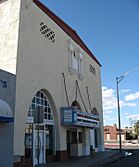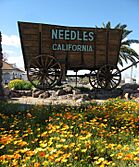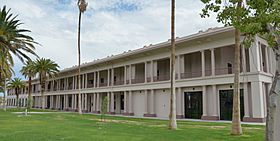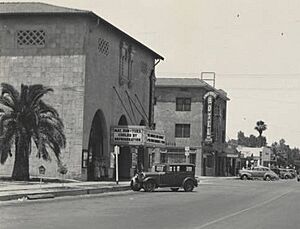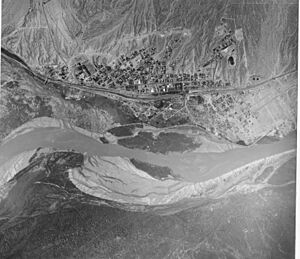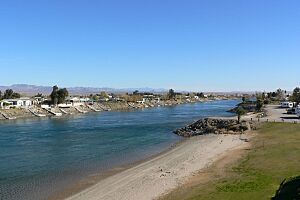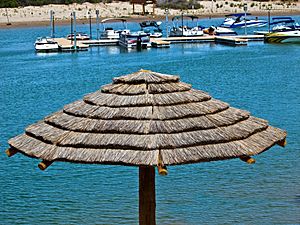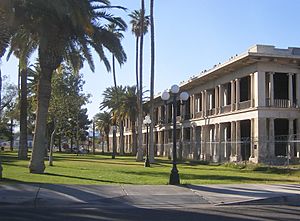Needles, California facts for kids
Quick facts for kids
Needles, California
|
|
|---|---|
|
Top: Needles Theatre (left), town sign (right); bottom: El Garcés.
|
|
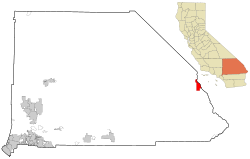
Location in San Bernardino County and the state of California
|
|
| Country | |
| State | |
| County | San Bernardino County |
| Incorporated | October 30, 1913 |
| Named for | The Needles |
| Area | |
| • Total | 31.08 sq mi (80.49 km2) |
| • Land | 30.58 sq mi (79.20 km2) |
| • Water | 0.50 sq mi (1.29 km2) 1.49% |
| Elevation | 495 ft (151 m) |
| Population
(2020)
|
|
| • Total | 4,959 |
| • Density | 162.73/sq mi (62.83/km2) |
| Time zone | UTC−8 (Pacific) |
| • Summer (DST) | UTC−7 (PDT) |
| ZIP Code |
92363
|
| Area codes | 442/760 |
| FIPS code | 06-50734 |
| GNIS feature IDs | 1652757, 2411220 |
Needles is a city in eastern San Bernardino County, California. It is located in the Mojave Desert region of Southern California. Needles sits on the western banks of the Colorado River, close to the borders of Arizona and Nevada.
You can reach the city by using Interstate 40 and U.S. Route 95. In 2020, about 4,959 people lived in Needles. This was a small increase from 4,844 people in 2010.
Contents
History of Needles
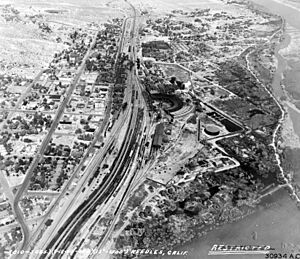
The area where Needles is now was first home to the Mojave Indians.
Needles was started in May 1883. This happened when the Atchison, Topeka and Santa Fe Railway was being built. The railway first crossed the Colorado River near Eastbridge, Arizona. This spot was about three miles southeast of where Needles is today.
The city got its name from "The Needles". This is a group of tall, pointed rocks called pinnacles. They are in the Mohave Mountains on the Arizona side of the river. The first place chosen for the bridge was not very good. It did not have strong river banks or a solid bottom.
A bridge was built, but it was not very strong. It was also in the way of boats on the river. Floods on the Colorado River destroyed this bridge three times. This happened in 1884, 1886, and 1888. The railway then built a new, stronger bridge called Red Rock Bridge. This was a high cantilever bridge built ten miles downstream. It was finished in May 1890, and the old bridge was taken down.
At first, Needles was just a camp with tents for the railroad workers. But soon, the railway built a hotel, car sheds, shops, and a roundhouse. In just one month, Needles had many businesses. These included a Chinese laundry, a newsstand, a restaurant, and several stores. It also had many saloons.
Needles quickly became the biggest port on the river above Yuma, Arizona. In 1908, the railway and the Fred Harvey Company built the beautiful El Garces Hotel. This hotel was known as the "crown jewel" of the Fred Harvey chain. The building is now a historic landmark and is being restored.
Needles was an important stop on the famous U.S. Route 66 highway. This was true from the 1920s to the 1960s. For families moving from the Midwest during the Dust Bowl in the 1930s, Needles was their first stop in California. The city still has many old motels and shops from that time.
The "Carty's Camp" from the movie The Grapes of Wrath was in Needles. It is now a ghost tourist spot. Its remains are behind the old 66 Motel.
In 1949, the United States Bureau of Reclamation started a big project. They dug a new, straighter channel for the Colorado River. This helped with problems caused by silt after the Hoover Dam was built.
Today, Needles is a popular place for tourism and recreation. It is the eastern entrance to the Mojave National Preserve. This is a beautiful desert area.
-
Trains at El Garcés, around 1908.
Geography and Climate
Needles' Location
Needles is located in a hot desert climate. This means it has very hot summers and mild winters. The average yearly temperature is about 76.2°F (24.6°C).
Extreme Heat in Needles
Needles is famous for its extreme heat in the summer. It is often one of the hottest places in the United States. The National Oceanic and Atmospheric Administration (NOAA) often reports Needles as having the highest daily temperature.
On July 22, 2006, Needles had a record high low temperature of 100°F (38°C) at 6:00 am. The high temperature that day was over 120°F (49°C). This makes it one of the few places on Earth where the overnight temperature stayed above 100°F.
On August 13, 2012, Needles had a thunderstorm with rain that was 115°F (46°C). This set a new world record for the hottest rain ever. The air temperature was 118°F (48°C) at the time. Because the air was very dry (only 11% humidity), the rain evaporated quickly. Very little rain actually reached the ground.
On May 4, 2014, Needles reached 102°F (39°C) with extremely low humidity. This was the lowest humidity ever recorded on Earth when rain occurred.
Winter and Rainfall
In winter, temperatures in Needles are usually mild. December, the coolest month, has an average temperature of about 54.7°F (12.6°C). July is the hottest month, with an average temperature of about 98.5°F (36.9°C).
Needles typically has 119 days a year where the temperature reaches 100°F (38°C) or higher. It has about 175 days where it reaches 90°F (32°C) or higher. Temperatures rarely drop to 32°F (0°C) or lower, happening about 2.7 days a year. The coldest temperature ever recorded was 18°F (-8°C) in January 1937. The hottest was 125°F (52°C), last seen in June 2017.
The city gets about 4.32 inches (110 mm) of rain each year. It rains on about 23 days a year. Snowfall is very rare. The only time measurable snow fell was in January 1949, when 15.2 inches (38.6 cm) fell. Needles can also have thunderstorms during the monsoon season.
Needles receives weather updates from the National Weather Service's NOAA Weather Radio.
| Climate data for Needles Airport, California (1991–2020 normals, extremes 1888–present) | |||||||||||||
|---|---|---|---|---|---|---|---|---|---|---|---|---|---|
| Month | Jan | Feb | Mar | Apr | May | Jun | Jul | Aug | Sep | Oct | Nov | Dec | Year |
| Record high °F (°C) | 85 (29) |
92 (33) |
99 (37) |
107 (42) |
118 (48) |
125 (52) |
125 (52) |
123 (51) |
120 (49) |
112 (44) |
92 (33) |
83 (28) |
125 (52) |
| Mean maximum °F (°C) | 75.4 (24.1) |
80.7 (27.1) |
91.3 (32.9) |
100.8 (38.2) |
108.0 (42.2) |
115.6 (46.4) |
118.4 (48.0) |
116.7 (47.1) |
111.5 (44.2) |
101.3 (38.5) |
87.4 (30.8) |
74.6 (23.7) |
119.6 (48.7) |
| Mean daily maximum °F (°C) | 66.4 (19.1) |
71.0 (21.7) |
79.1 (26.2) |
86.6 (30.3) |
96.2 (35.7) |
106.4 (41.3) |
110.5 (43.6) |
109.3 (42.9) |
102.6 (39.2) |
89.5 (31.9) |
75.1 (23.9) |
64.5 (18.1) |
88.1 (31.2) |
| Daily mean °F (°C) | 56.2 (13.4) |
59.9 (15.5) |
66.6 (19.2) |
73.7 (23.2) |
83.1 (28.4) |
93.0 (33.9) |
98.5 (36.9) |
97.4 (36.3) |
90.0 (32.2) |
77.0 (25.0) |
63.8 (17.7) |
54.7 (12.6) |
76.2 (24.6) |
| Mean daily minimum °F (°C) | 46.0 (7.8) |
48.8 (9.3) |
54.1 (12.3) |
60.8 (16.0) |
70.0 (21.1) |
79.6 (26.4) |
86.6 (30.3) |
85.4 (29.7) |
77.3 (25.2) |
64.6 (18.1) |
52.5 (11.4) |
45.0 (7.2) |
64.2 (17.9) |
| Mean minimum °F (°C) | 34.0 (1.1) |
37.1 (2.8) |
41.9 (5.5) |
48.6 (9.2) |
56.5 (13.6) |
66.2 (19.0) |
75.6 (24.2) |
74.9 (23.8) |
65.0 (18.3) |
51.5 (10.8) |
39.7 (4.3) |
33.4 (0.8) |
31.8 (−0.1) |
| Record low °F (°C) | 18 (−8) |
22 (−6) |
29 (−2) |
33 (1) |
39 (4) |
46 (8) |
57 (14) |
60 (16) |
40 (4) |
34 (1) |
25 (−4) |
20 (−7) |
18 (−8) |
| Average precipitation inches (mm) | 0.73 (19) |
0.79 (20) |
0.51 (13) |
0.18 (4.6) |
0.07 (1.8) |
0.04 (1.0) |
0.27 (6.9) |
0.39 (9.9) |
0.34 (8.6) |
0.22 (5.6) |
0.34 (8.6) |
0.44 (11) |
4.32 (110) |
| Average precipitation days (≥ 0.01 in) | 3.3 | 3.7 | 2.9 | 1.3 | 0.7 | 0.3 | 1.8 | 1.9 | 1.8 | 1.6 | 1.5 | 2.3 | 23.1 |
| Mean monthly sunshine hours | 248 | 254.3 | 310 | 360 | 403 | 420 | 403 | 372 | 330 | 310 | 240 | 248 | 3,898.3 |
| Mean daily sunshine hours | 8 | 9 | 10 | 12 | 13 | 14 | 13 | 12 | 11 | 10 | 8 | 8 | 11 |
| Percent possible sunshine | 79 | 82 | 83 | 92 | 93 | 97 | 92 | 90 | 89 | 88 | 78 | 81 | 87 |
| Average ultraviolet index | 3 | 4 | 6 | 8 | 9 | 10 | 11 | 10 | 8 | 5 | 4 | 2 | 7 |
| Source 1: NOAA WRCC | |||||||||||||
| Source 2: Weather Atlas (sun and uv) | |||||||||||||
People Living in Needles (Demographics)
| Historical population | |||
|---|---|---|---|
| Census | Pop. | %± | |
| 1920 | 2,807 | — | |
| 1930 | 3,144 | 12.0% | |
| 1940 | 3,624 | 15.3% | |
| 1950 | 4,051 | 11.8% | |
| 1960 | 4,590 | 13.3% | |
| 1970 | 4,051 | −11.7% | |
| 1980 | 4,120 | 1.7% | |
| 1990 | 5,191 | 26.0% | |
| 2000 | 4,830 | −7.0% | |
| 2010 | 4,844 | 0.3% | |
| 2019 (est.) | 4,976 | 2.7% | |
| U.S. Decennial Census | |||
Population in 2010
In 2010, the population of Needles was 4,844 people. Most people lived in homes. About 75.7% of the people were White. Other groups included African American (2.0%), Native American (8.2%), and Asian (0.7%). About 22.4% of the population was Hispanic or Latino.
There were 1,918 households in Needles. About 33.9% of these households had children under 18 living there. The average household had 2.52 people. The average family had 3.12 people.
The population was spread out by age. About 26.5% were under 18 years old. About 15.8% were 65 years or older. The average age was 39.3 years.
In 2010, the average income for a household in Needles was $29,613. About 28.8% of the people lived below the poverty line.
Jobs in Needles
The main source of jobs in Needles is the BNSF Railway. This railroad company has been a major employer for over a hundred years. The depot in Needles has been a crew change point for the railway since the late 1800s.
Needles is smaller than some nearby cities now. These include Bullhead City, Arizona, Lake Havasu City, Arizona, and Laughlin, Nevada.
Education in Needles
The city of Needles is part of the Needles Unified School District. This district is one of the largest in the United States by area. It covers almost 6,000 square miles (15,500 km²). The district stretches from Amboy to Needles and south to Parker Dam. In 2022, there were 955 students enrolled in the district.
Local schools in Needles include:
- Katie Hohstadt Elementary School (now home to Needles Head Start)
- Vista Colorado Elementary School (for grades K–5)
- Needles Middle School (for grades 6–8)
- Needles High School (for grades 9–12)
- The Educational Training Center (for grades 9–12)
Because Needles High School is far from other California schools, it is part of the Nevada Interscholastic Activities Association. This means its sports teams compete against schools in Nevada.
Needles also has two private schools:
- Needles Assembly of God Christian School
- Needles Seventh-day Adventist School
Transportation in Needles
Major Roads
Interstate 40, also called the Needles Freeway, is the main highway through the city. It connects Needles to Barstow in the west and to Arizona in the east. U.S. Route 95 also comes into Needles from the east. It runs together with I-40 for a bit, then heads north towards Nevada. The Colorado River Bridge connects Needles directly to Mohave County, Arizona, and Arizona State Route 95.
Train and Bus Services
Amtrak, the national passenger train system, offers daily service to the Needles station. The train, called the Southwest Chief, travels between Chicago and Los Angeles. It usually arrives in Needles between midnight and 2 am.
Local bus service in the Needles area is provided by Needles Area Transit.
Since August 2, 2016, the Victor Valley Transit Authority also offers bus service from Needles to Barstow and Victorville on Fridays. The bus leaves Needles at 6:15 am and arrives in Victorville at 10:30 am. For the return trip, buses leave Victorville at 2:30 pm and arrive in Barstow at 7:15 pm.
Vegas Airporter provides shuttle service between Lake Havasu City, Needles, and Harry Reid International Airport in Las Vegas.
Famous People from Needles
- Pat Morris was the Mayor of San Bernardino, California.
- Max Rafferty was the Needles Superintendent of Schools from 1955 to 1961. He later became California's Superintendent of Public Instruction.
- Charles Schulz, the cartoonist who created Peanuts, lived in Needles from 1928 to 1930. He made Needles the home of Snoopy's brother, Spike.
- Bess Houdini, the wife and assistant of the famous escape artist Harry Houdini, passed away in Needles in 1943.
- Yara tav, a leader of the Mohave people (1861–1874), was born near the Needles rock formation before the town existed.
- Alice Notley, an American poet, grew up in Needles.
- Natalie Diaz, an American poet, won the 2021 Pulitzer Prize for Poetry.
|
See also
 In Spanish: Needles (California) para niños
In Spanish: Needles (California) para niños


